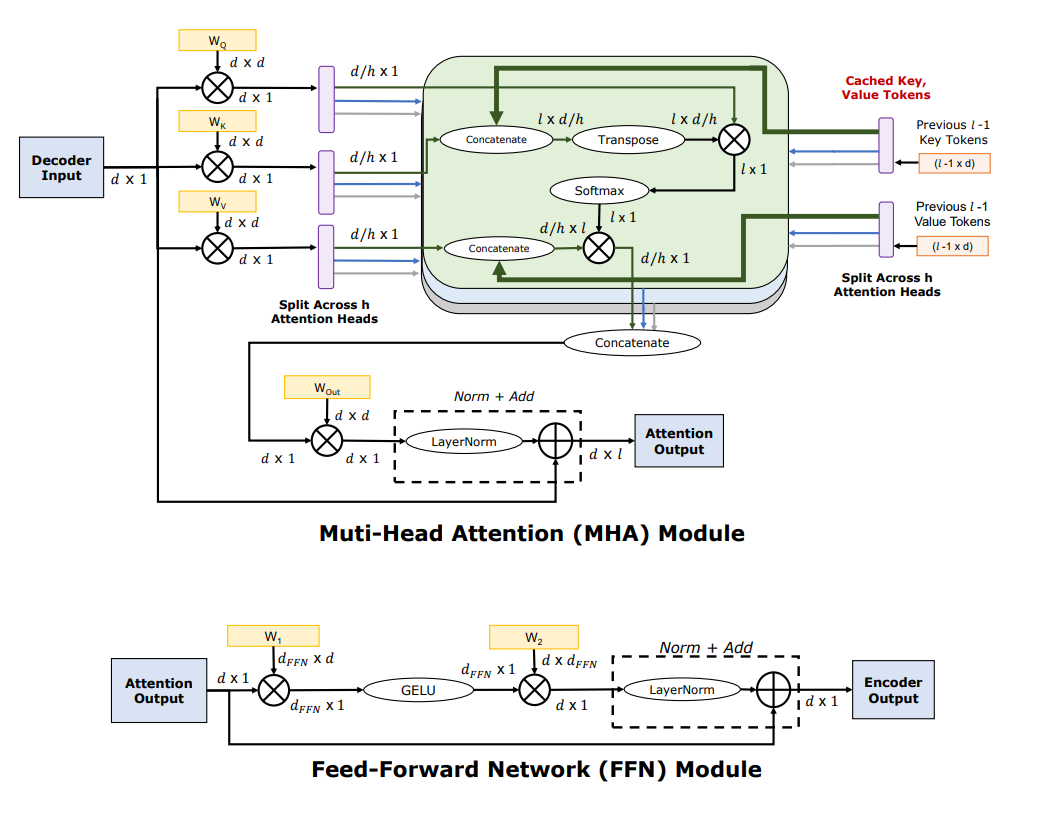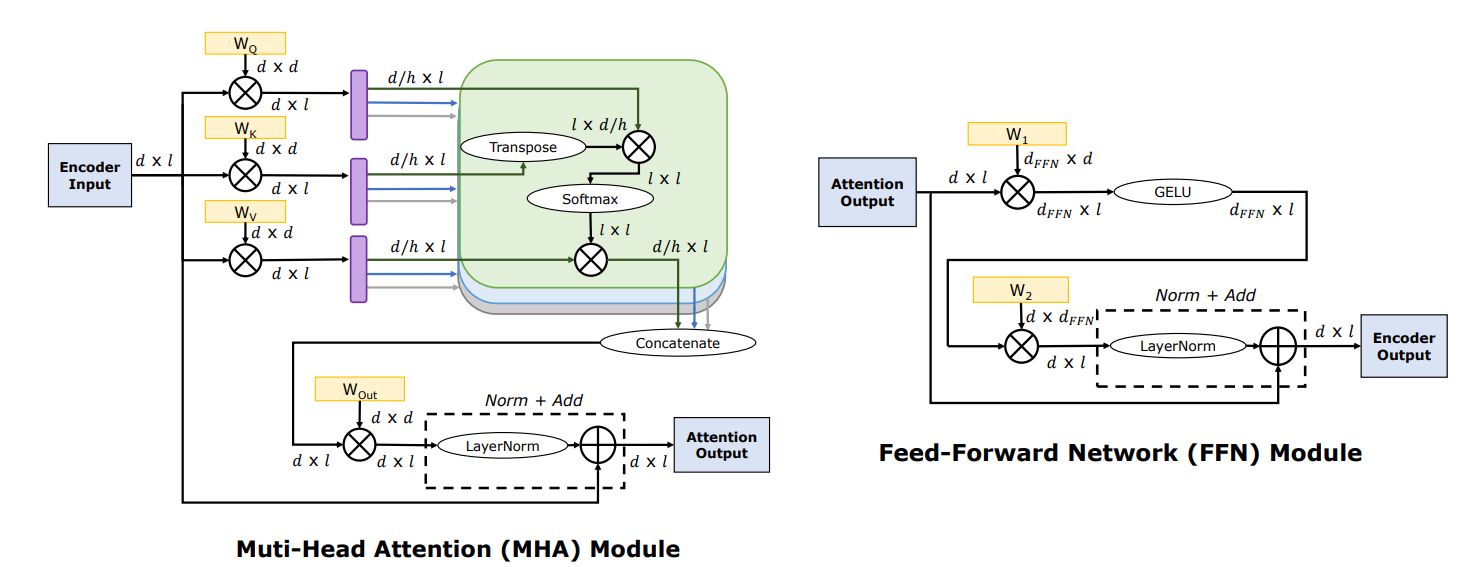简介
本文主要介绍 LLaMA 模型细节和代码实现,在实现 LLaMA 基座模型基础上介绍 [LoRA]() 模型细节和代码实现。
注意:本文部分给出代码与原实现有些许差异。使用 LLaMA-7B 模型作为示例。
模型细节
LLaMA 模型主要基于 Transformer 架构。以 LLaMA-7B 模型为例,部分参数有:词表大小 32000,词嵌入维数 4096,注意力头 32,Transformer 层 32。整体处理流程如下,细节详见后文:
- 将句子通过 tokenizer 模型,转化字符串为 tokens 列表,实现字符串到整数列表的转化,即
str -> List[int],长度为seq_len。 - 将 tokens 列表,通过 embedding 层(简单的 lookup table),将 tokens 列表转化为词嵌入向量,即
List[int] -> float[seq_len, embdding_dim]。 - 通过 N 层的 Transformer 层,得到
float[seq_len, embedding_dim]。 - 通过 output 层,将输出转化为词表概率,取其中最大值或者依概率取值最为最后预测词。
其中 Transformer 的 Decoder 和 Encoder 见下图, prompt 的计算使用 decoder 部分算法,后续词预测使用 encoder 部分算法:


线性层 - Linear
计算方式 :
$$ output = data * weight^T $$
代码实现:
class Linear(nn.Module):
def __init__(self, weight: torch.Tensor):
super().__init__()
self.weight_ = weight
def forward(self, data: torch.Tensor) -> torch.Tensor:
return torch.matmul(data, self.weight_.transpose(0, 1))归一化层 - RMSNorm
计算方式:
$$ o_i = \frac{a_i * w_i}{\sqrt{\frac{1}{n}\sum_{i=1}^na_i^2}} $$
代码实现:
class RMSNorm(nn.Module):
def __init__(self, weight: torch.Tensor, eps: float = 1e-06):
super().__init__()
self.norm_eps_ = eps
self.weight_ = weight
def _norm(self, data: torch.Tensor) -> torch.Tensor:
return data * torch.rsqrt(data.pow(2).mean(-1, keepdim=True) + self.norm_eps_)
def forward(self, data: torch.Tensor) -> torch.Tensor:
output = self._norm(data.float()).type_as(data)
return output * self.weight_位置信息嵌入 - RotaryEmbedding
对词向量进行位置信息嵌入,计算方式:
$$ \left(\begin{matrix} e_0 \\ e_1 \\ \cdots \\ e_{d-2} \\ e_{d-1} \\ \end{matrix} \right) \times \left(\begin{matrix} cos\theta_0 \\ cos\theta_0 \\ \cdots \\ cos\theta_{d/2-1} \\ cos\theta_{d/2-1} \\ \end{matrix} \right) + \left(\begin{matrix} -e_1 \\ e_0 \\ \cdots \\ -e_{d-1} \\ e_{d-2}\\ \end{matrix} \right) \times \left(\begin{matrix} sin\theta_0 \\ sin\theta_0 \\ \cdots \\ sin\theta_{d/2-1} \\ sin\theta_{d/2-1} \\ \end{matrix} \right) = \left(\begin{matrix} o_0 \\ o_1 \\ \cdots \\ o_{d-2} \\ o_{d-1} \\ \end{matrix} \right) $$
其中词向量维度为每一个注意力头的维度,即总维度数量 / 注意力头数量。
第 i 个词的第 t 个角度计算方式:
$$ \theta_{i,t} = \frac{i}{10000^{\frac{2t}{d}}} $$
其中 i 为词所在位置,d 为词向量维数,由上述嵌入公式可知仅需 2/d 个角度, t 即为第 t 个角度。
转化为复数可简化计算,计算方式:
$$ (cos\theta_0 + sin\theta_0i)\times(e_0+e_1i)=(e_0cos\theta_0-e_1sin\theta_0)+(e_1cos\theta_0+e_0sin\theta_0)i $$
可预先准备最大词数量 * (注意力头维度 / 2) 的矩阵,与转化为复数形式的词向量相乘:
$$ \left(\begin{matrix} cos\theta_{i,0} + sin\theta_{i,0}i \\ cos\theta_{i,1} + sin\theta_{i,1}i \\ \cdots \\ cos\theta_{i,t-2} + sin\theta_{i,t-1}i \\ cos\theta_{i,t-2} + sin\theta_{i,t-1}i \\ \end{matrix} \right) \times \left(\begin{matrix} e_0+e_1i \\ \cdots \\ \cdots \\ \cdots \\ e_{d-2}+e_{d-1}i \\ \end{matrix} \right) $$
代码实现:
def precompute_rope_angle(dim: int, seq_len: int, theta: float = 10000.0) -> torch.Tensor:
angles = 1.0 / (theta ** (torch.arange(0, dim, 2) / dim))
seq = torch.arange(seq_len)
freqs = torch.outer(seq, angles)
# 1*cos(angle) + 1*sin(angle)i
angle_complex = torch.polar(torch.ones_like(freqs), freqs)
return angle_complex
def apply_rotary_emb(data: torch.Tensor, angle: torch.Tensor) -> torch.Tensor:
# data shape is: seq_len * n_head * n_dim
# convert data shape into complex: seq_len * n_head * (dim // 2)
seq_len, n_head, dim_head = data.shape
data = torch.view_as_complex(data.reshape(
seq_len, n_head, dim_head // 2, 2))
angle_ = angle[:seq_len].view(seq_len, 1, dim_head // 2)
return torch.view_as_real(data * angle_).flatten(2)Transformer 层
代码实现
class Transformer(nn.Module):
def __init__(self, layer_id: int, args: LlamaModelArgs):
super().__init__()
# attention
self.wq_: Linear = None # dim * dim
self.wk_: Linear = None # dim * dim
self.wv_: Linear = None # dim * dim
self.wo_: Linear = None # dim * dim
# feed forward
self.w1_: Linear = None # also gate FNN * dim
self.w2_: Linear = None # also down dim * FNN
self.w3_: Linear = None # also up FNN * dim
# norm
self.attention_norm_: RMSNorm = None # dim
self.ffn_norm_: RMSNorm = None # dim
def forward(self, data: torch.Tensor, rope_angle: torch.Tensor):
# data shape: seq_len * dim
seq_len, _ = data.shape
attention_norm_data = self.attention_norm_.forward(data)
xq = self.wq_.forward(attention_norm_data)
xk = self.wk_.forward(attention_norm_data)
xv = self.wv_.forward(attention_norm_data)
# conver shape to multi head
xq = xq.view(seq_len, self.n_heads_, self.head_dim_)
xk = xk.view(seq_len, self.n_heads_, self.head_dim_)
xv = xv.view(seq_len, self.n_heads_, self.head_dim_)
# apply rotary embedding
rotary_xq, rotary_xk = apply_rotary_emb(xq, xk, rope_angle)
# shape is: n_head * seq_len * dim_head
xq = rotary_xq.transpose(0, 1)
xk = rotary_xk.transpose(0, 1)
xv = xv.transpose(0, 1)
scores = torch.matmul(xq, xk.transpose(1, 2)) / \
math.sqrt(self.head_dim_)
# need mask the score, score shape is : seq_len * seq_len
mask = torch.full((seq_len, seq_len), float("-inf"))
mask = torch.triu(mask, diagonal=1).type_as(scores)
scores = scores + mask
scores = F.softmax(scores.float(), dim=-1).type_as(xq)
# score shape is: n_head * seq_len * dim_head
attention_score = torch.matmul(scores, xv)
# convert shape to: seq_len * dim
attention_score = attention_score.transpose(
0, 1).contiguous().view(seq_len, -1)
# get output attention score
attention_output_score = self.wo_.forward(attention_score)
attention_output = attention_output_score + data
# feed forward fully connected
score_norm_data = self.ffn_norm_.forward(attention_output)
w1_data = self.w1_.forward(score_norm_data)
w3_data = self.w3_.forward(score_norm_data)
decoder_output = self.w2_(F.silu(w1_data) * w3_data)
return attention_output + decoder_outputLLaMA 模型
代码实现
class LlamaModel(nn.Module):
def __init__(self, args: LlamaModelArgs):
super().__init__()
self.token_embedding_: torch.Tensor = None
self.layers_: List[Transformer] = []
for layer_id in range(args.n_layers_):
self.layers_.append(Transformer(layer_id, args))
self.norm_: RMSNorm = None # dim
self.output_: Linear = None # vocab size * dim
def forward(self, input_tokens: List[int]):
tokens = torch.tensor(input_tokens, dtype=torch.int)
data = F.embedding(tokens, self.token_embedding_)
for layer in self.layers_:
data = layer.forward(data, self.rope_angle_)
data = self.norm_.forward(data)
output = self.output_.forward(data)
return outputLoRA 模型实现
LoRA 模型对 Transformer 层中的 Linear 进行替换,加入 LoRA_A 和 LoRA_B 两层,进行降秩和升秩。
代码实现
class Linear(nn.Module):
def __init__(self, weight: torch.Tensor):
super().__init__()
self.weight_ = weight
# lora weight
self.lora_a_: torch.Tensor # r * dim
self.lora_b_: torch.Tensor # dim * r
# common paramas
self.lora_dropout_: float = 0
self.r_: int = 0
self.lora_alpha_: int = 0
self.scaling_: float = 0
def forward(self, data: torch.Tensor) -> torch.Tensor:
result = torch.matmul(data, self.weight_.transpose(0, 1))
data_ = F.dropout(data, self.lora_dropout_)
data_ = torch.matmul(data_, self.lora_a_.transpose(0, 1))
data_ = torch.matmul(data_, self.lora_b_.transpose(0, 1))
data_ = data_ * self.scaling_
return result + data_